“Petra never closes, you don’t need to hurry”, says a donkey owner/guide/hustler. Pointing to the villages scattered in the surrounding mountains, he continues: “Petra has many entrances and exits. Take another exit to see more tombs in a different part of the site. I can even cook a Bedouin dinner for you under the moonlight. Be my guest. Petra is always open.” Polite and firm —as I’ve done countless times on this day— I reply, “No, thank you. I’ll go back to the Treasury to capture a photo without a tourist in it.”
PETRA IN A NUTSHELL
Petra, aptly named after a Greek word meaning ‘rock’, is an ancient city, partly built, partly carved into the red-rose sandstone rocks surrounded by rugged desert canyons and mountains. Petra was first established sometime around the 6th century BC by the Nabataean Arabs, and it was the great capital of the Nabataean Empire between 400 B.C. and A.D. 106, by which time the Romans took over. Petra, situated between the Red Sea and the Dead Sea in today’s southwestern corner of Jordan, was an important hub on the trade route linking Arabia, Egypt, and Syria with China in the east and Rome in the west. As the Roman Empire moved its focus to Constantinople during the Byzantine period, Petra sunk into oblivion eventually. The fallen glory of Petra remained ‘lost’ to the Western world for centuries.
The sheer sandstone cliffs kept the secret of this once mighty caravan city until it was rediscovered by the Swiss explorer Burckhardt in 1812. Petra was declared a UNESCO World Heritage site in 1985, and in 2007 it was elected as one of the New Seven Wonders of the World.
| Petra, down there hidden in the canyon |
The city of Petra is vast, comprised of hundreds of rock-cut tombs, houses, temples, obelisks, colonnaded streets, a Roman-style amphitheater, and sacrificial altars, and high above, overlooking the valley, is the impressive Ad-Deir Monastery. Due to its significant geographical location, Petra was occupied by many different tribes over its history but all the excavated monuments and buildings visible today are a blend of the Nabataean and Greco-Roman periods.
In any case, a visit to Petra involves a great deal of walking. To be more precise for the very fit, it means roughly 20 km in total to cover all the important sights in a single day:
- The Siq, meaning ‘gorge’, is the ancient main entrance that leads to the city
- The Treasury is the most treasured sight framed at the end of the Siq
- The ‘Downtown’ is the main plaza with tombs, temples, theater, streets, and the majority of hustlers
- The Monastery is a giant rock-cut architecture sitting high on the mountain overlooking Jordan’s ‘Grand Canyon’
- The High Place of Sacrifice is an altar at the very top of a hill where the rock was leveled off to offer up sacrifices
- Al-Khubtha is the mountain offering an adventurer’s perspective of the Treasury from a dizzying angle
20 km of walking —that’s if you are determined not to use any of more than 1000 animals put to work transporting tourists around this giant rock-cut city.
THE SIQ
The Siq, a slot canyon about 1 km in length, still serves as the official entrance passage to the hidden city of Petra, just as in antiquity.
 |
| High cliffs in the twilight |
Walking through the Siq is an awe-inspiring experience in itself —after you’ve successfully got rid of the horse-drawn carriage drivers, bugging you to take the ride included in the ticket price. Stand firm. A few hundred meters later they’ll give up, and instead, bizarre sandstone cliff faces on either side will start to rise higher and higher up to 80 meters.
 |
| Occasional sunlight glinting on the cliff face high above |
The path twists and squeezes through the high rocks with dazzling formations and colors in perpetual twilight, not revealing more than a few meters ahead.
What appears to be an endless snaking path suddenly opens onto a massive soaring facade (25 meters wide and 40 meters high) dwarfing everything around it.
This elegantly carved dusky-pink sandstone face is the Treasury (Al Khazneh), the most famous monument at Petra.
THE TREASURY
As you step into the sunlight, camels in the doorway of the towering ancient structure emphasize its enormity. Soon, the very first tourists start to take their inevitable camelback rides, milling around the Treasury and posing for photos.
The Treasury is possibly the most photographed sight at Petra. As such, it’s always crowded, especially at midday. My attempt to have the place to myself fails even at around 6:30 am just after sunrise (even though it’s best observed fully lit by the mid-morning sun).
The longer I wait for the perfect capture, the more people arrive. Quickly realizing that the situation in front of the most famous monument at Petra won’t get any better, I decide to come back here later and head to the Monastery, to at least beat the crowds up there.
After all, the Treasury is merely the first of the many wonders that make up Petra.
THE DOWNTOWN
From the open space beyond Treasury, a dusty trail passes through the actual city with great tombs on either side. a theater, temples, palaces, baths, and private houses.
 |
| Entrance of a tomb |
 |
| Inside a tomb |
The ruins around here, mainly Roman style, are not as impressive as the surrounding hills. And perched atop a hill, tall and proud against the blue sky is the Ad-Deir Monastery. As I hurry towards it, to climb the 800+ stone steps, a little boy on a donkey —perhaps 6 years old— offers me a ride. I refuse him saying, maybe on the way back if I feel tired. He responds with a smile on his face and no sign of disappointment that he would find me and heads over to the next tourist.
I barely walk a few meters before another boy —this time around 10 years old— tries to convince me to take a ride. I give him the same reply. But given his more experienced age, he says frustrated, “No, you won’t make my day.” I feel deeply sorry for him, but I am determined not to use any animals.
Petra’s animals are kept in poor conditions with far too long working days and carrying weights that are often far too heavy for their size. The owners are often oblivious to their animals’ welfare and force them to work even with injuries.
On the main tourist route, besides the high population of horses, donkeys, mules, camels, and their owners, plenty of Bedouins from nearby villages set up small stalls hawking various local handicrafts, soft drinks, water, and snacks. I feel lucky to get disturbed only by these two boys in the early morning hours, and the Bedouin-run stalls are about to pop up yet.
THE MONASTERY
The hike up the well-worn staircase at the end of the main tourist route is not as difficult as the animal owners exaggerate. So I reach the impressive Monastery, Ad-Deir.
The Monastery is Petra’s largest facade, carved directly into a raw wall of rock that sits high on a sheer mountainside. I relish a front-on view of the monument from the shade of the cave café, mint tea in hand.
 |
| The people in front of the door, through which a bus can pass, show the grand scale of the structure. |
There are several vantage points up here, all claim to have the best panoramic vistas over the Grand Canyon of Jordan, Wadi Arabah.
Refreshed, I hike up some of the various paths for THE best view signposted by Bedouins towards their shacks. Indeed, the views are truly wonderful and I enjoy the 360-degree vistas across the valley.
When the first herd of tourist-laden donkeys arrives, I descend back down. There are still two more mountains to visit for the afternoon.
On my descent from the Monastery, I take in the sweeping views towards Petra city center and the Royal Tombs below.
By now, the pop-up shop owners are ready to hustle and wares literally fly in the air, all for 1 JD (1.5 USD).
As I further walk down the stairs, Adnan, just another donkey owner, offers me a ride. “No, I am good,” I say. “But you still have two mountains to visit, the trail is not well marked and you’ll get lost. It’s far, so far,” He speaks. “No, I am good. I am really good on foot,” I repeat. A visit to Petra involves a great deal of walking and I am determined not to use any animals.
 |
| Adnan’s donkey |
Adnan takes his unladen donkey down, but he crosses my path several times until I reach the downtown area. As many selling arguments as he has, I have excuses. “I am afraid of donkeys,” I say. “No, no don’t worry. I’ll be with you at all times. My donkey is very sweet-tempered,” He claims. “No, I fell off a donkey on a straight road and broke my arm. There’s no way I climb onto that animal and ride over these rough and slippery trails,” I elaborate. Pointing to a scar on his forehead, he tells me that he fell off a galloping horse as a child and spent 3 days in the hospital —unconscious. “Don’t worry, I am with you. Two mountains, 20 JD, all afternoon, deal?” He asks. “No, 10 JD. Otherwise, I am walking,” I reply and hope that he wouldn’t agree. And yep, he shows me the way to the High Place of Sacrifice and turns around. Thanking him, I start walking.
Moments later he calls behind me, “OK, 10 Dinar!” And I give in.
HIGH PLACE OF SACRIFICE & CARAVAN ROUTE ON A DONKEY
From the downtown area, valleys go off in all directions. We navigate through towering canyons to the High Place of Sacrifice for more stupendous vistas, and to explore the Roman Soldier’s Tomb and other remote sites.
The ancient highways that once carried caravans laden with incense, silk, myrrh, spices, and other exotic goods, are today a tourists’ playground. And I am no exception: Saddled up on a donkey, I contribute to the tourist traffic. Surprisingly though, we encounter not more than a handful of other people along the way and I do enjoy the ride accompanied by a fresh breeze and fantastic views over the tentacles of Petra’s trails and ruins spread across the undulating russet-hued desert slopes.
Narrow goat trails wind across the cliffs and occasional flights of rock-cut steps spiral their way through the edge of the mountains. But the donkey knows the way by heart, where to stop for the best view, and even where to rest. As we stop by the ruins of a caravanserai en route to Egypt, all the puzzle pieces of Petra’s ancient civilization make all of a sudden sense. They all fit perfectly into the big picture giving a sense of the vast trading network, the very reason for Petra’s glory.
We further scramble to the summit along the stony paths which worshipers climbed on their way to the high places of sacrifice. Natural and man-made beauties greet the eye at every turn. As we reach the very top of the hill, I gaze over the picturesque lost city and imagine the bustling Petra of old. Away from the hubbub of the main tourist route, one can admire the spellbinding natural vistas that truly capture the vastness of this ancient city.
TREASURY FROM ABOVE
As we approach the main plaza, a hubbub of human noise rising in volume stresses the fact that today’s Petra is one of the world’s most popular sights. Yet it’s perfectly possible to escape the crowds. In order to admire the work of Nabataean craftsmen from the vertiginous cliff opposite, we follow the staircase slicing into the rock past Royal Tombs.
Oblivious Passenger, Oblivious Owner
There is a noticeable increase in tourist traffic along the trail to Al-Khubtha Mountain, and most of the animal owners aim to ferry as many passengers as possible. As we slowly start climbing the stairs, a big guy jumping on a skinny donkey with all his might catches my attention. His girlfriend warns him instantly not to be so cruel and insensitive to the poor animal. We then build a caravan of donkeys to climb up the tricky, rocky terrain. But the skinny donkey is reluctant to move forward. Obviously, it’s been a long and grueling day transporting tourists. Adnan talks to its owner, one of his many cousins, and makes us switch the donkeys, because I am lightweight and Adnan’s donkey is stronger. But even my weight is visibly too much for the poor donkey that I say I’d rather walk. Adnan tries to persuade me that the donkey is fine, but the moment I notice an open wound on the donkey’s neck, I insist on walking. After all, I’m not feeling tired and I can’t simply believe that the animal is doing fine.
Haggling is a Must
So we finally reach the viewpoint that can be accessed through a Bedouin shack as usual. Luckily the shop owner is not pushy. On the contrary, he is very polite and relaxed. He offers a little glass of mint tea for 1 JD. This seems to be the set price on everything and I can’t help but ask if they don’t have any coins in circulation, how a tiny glass of tea can cost that much. He tries to justify saying, somewhere else we’d have to pay for this view at least 5 JD. I respond that we’ve already paid 50 JD to enter this site. He explains with a smile that the government gets all that money, not himself, and the government does not want him to have a shop there. Instantly I rise a question as to whether he is paying taxes. A question that cracks everyone up. “You see, that’s the problem. You need to pay taxes. I’ll give you 1 JD but get two mint teas, OK?” I ask. He nods and starts playing on a one-stringed lute.
Vertigo-Inducing Views
I and two other tourists are the only ones contemplating this view from a dizzying drop below. A commanding display that makes the Treasury appear mini, and visitors ant-like whose echoes soar up into the air.
Sunset at Petra
The buzzing sound from the sandy plaza fronting the Siq fades away with the declining angle of the sun.
So we scramble our way down with the donkey jumping several steps at a time. I try hard not to turn a somersault over the donkey. Without a broken leg, arm, or skull, soon we arrive at the Royal Tombs where the sun highlights and enhances the amazing natural colors of the rocks already. Adnan drops me off here. I give him 15 JD for being such a good heart and treating his and even his friend’s animals so nicely. And I do hope he is not the only exception. I’d never imagined a donkey ride on stony paths leading to half-forgotten ruins and panoramic vistas would be the highlight of my day at Petra.
After bidding farewell, I linger a while to catch the colors of the sunset on the Royal Tombs and over the hills opposite.
GLORIOUS TREASURY GLORIOUSLY EMPTY OF VISITORS
I wait around the Royal Tombs until everyone else has hurried off back to their home —including the moonlight dinner offerer and restroom cleaning staff— before heading back to the Treasury.
In the twilight, I sit for a few minutes quietly and soak in the atmosphere at the centerpiece of the truly phenomenal ancient city of Petra.
Upon accomplishing my photo quest at the elegantly carved facade of the Treasury, I take one last look back through the Siq.
As I make my way through the Siq towards the exit, one of the last remaining horse-drawn carriage drivers asks “Ma’am, it’s getting dark. Don’t you want to take a ride?”
No, thanks. I want to walk.
Alone.

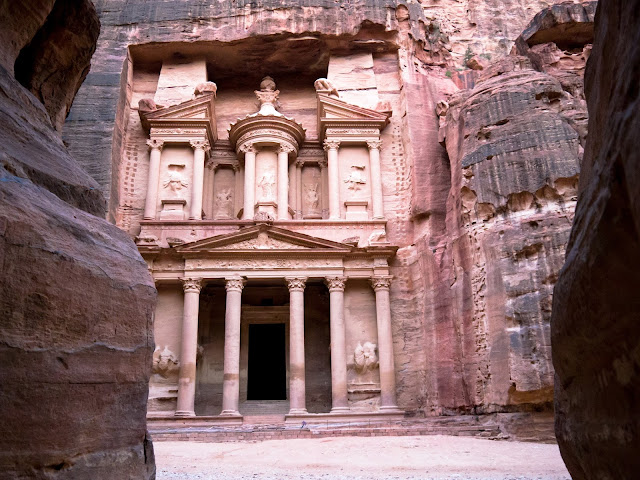
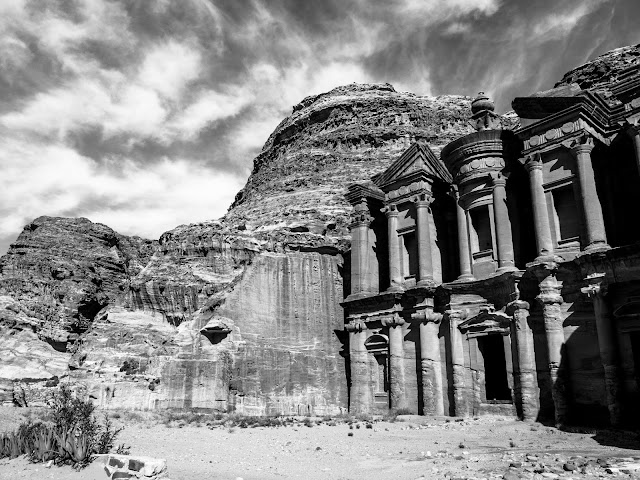




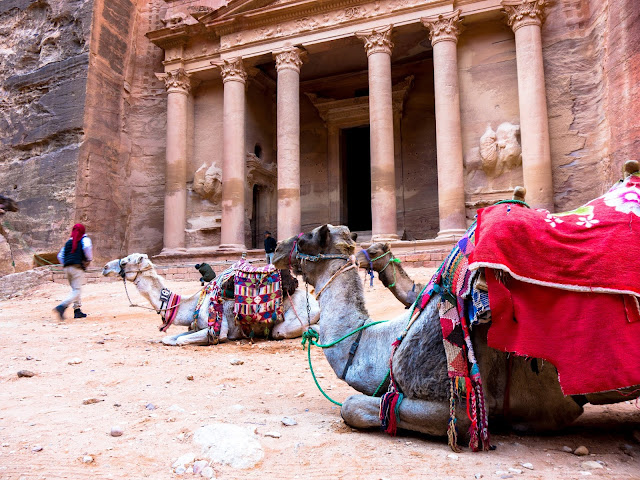



























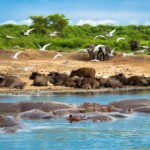
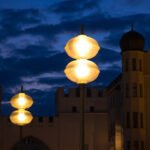

[…] Sea once again but also I was able to append a few days of holiday to visit Jordan. I wrote about Petra and Aqaba part of my trip already, but I am yet to bring “Desert Alone” on […]